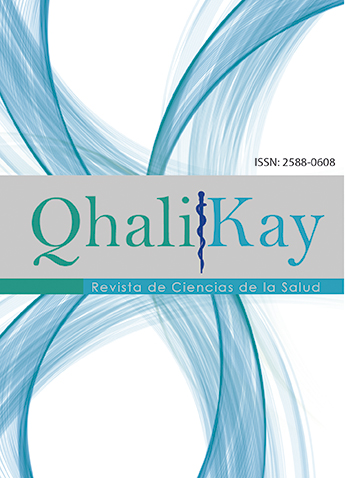Cesárea en el Hospital Verdi Cevallos Balda en el año 2015
Cesarean in Verdi Cevallos Balda Hospital in the year 2015
DOI:
https://doi.org/10.33936/qkrcs.v1i1.127Abstract
En los últimos años, el parto por cesárea ha aumentado en relación al parto transpelviano a nivel mundial, lo cual constituye una problemática de salud, teniendo en cuenta su asociación con la morbimortalidad de las pacientes y el incremento de los costes que representa. En este trabajo, se realizó un estudio observacional descriptivo en el Hospital Regional Doctor Verdi Cevallos Bal- da de la ciudad de Portoviejo, entre enero y diciembre de 2015, con el objetivo de determinar las indicaciones más frecuentes de la cesárea. El universo estuvo constituido por 3037 gestantes. La muestra fue de 1260 cesareadas que cumplieron con el criterio de inclusión como cesárea primiti- va, y de exclusión para las cesáreas iteradas y los partos transpelvianos. Los resultados mostraron que al 56,1% de las gestantes se les practicó cesárea. Dentro de los diagnósticos de la cesárea se observó predominio de la desproporción cefalopélvica con un 42,5% el compromiso de bienestar fetal con un 26,8% y la corioamnionitis un 0,1%, correspondiendo a las indicaciones maternas, fe- tales y ovulares respectivamente. Se concluyó que la indicación de cesárea, debe ser el resultado de una evaluación integral del estado maternofetal, sobre el que se decide la realización de este procedimiento quirúrgico.
Palabras clave: Cesárea, cefalopélvica, bienestar fetal, corioamnionitis
Abstract:
In recent years, cesarean has risen in relation to the transpelvic delivery worldwide, which is a pro- blem of health, taking into account its association with mortality and morbidity of patients and the increased costs which they represent. In this work, a descriptive observational study was conducted in the Regional Hospital Doctor Verdi Cevallos Balda in the city of Portoviejo, from January to De- cember 2015 with the objective of determining the most frequent indications for cesarean section. The universe consisted of 3037 pregnant women. The sample was cesarean section 1260 that met the inclusion criteria as early cesarean section, and exclusion for iterated transpelvic deliveries and caesarean sections. The results showed that 56.1% of pregnant women underwent caesarean section. Within diagnoses prevalence of caesarean section cephalopelvic disproportion to 42.5% was observed, the commitment of fetal well-being for 26.8% and 0.1% for chorioamnionitis, corres- ponding to maternal, fetal indications and ovular respectively. It was concluded that the indication of cesarean section, must be the result of a integral assessment of the maternal-fetal state, on which the realization of this surgical procedure is decided.
Key words: Cesarean, cephalopelvic, fetal well-being, corioamnionitis
Downloads
References
2. Marquini GV, Jorge MT y Pinto RM. Effectiveness of an educational intervention on the suitability of indications for cesarean delivery in a Brazilian teaching hospital. Int J Gynecol Obstet. [serial on the Internet]. 2014. [cited 2016 Aug 21]; Available from: http://dx.doi.org/10.1016/j.ijgo.2014.08.0113.
3. Zelli P, Boussat B, Wetzel A, Ronin C, Pons JC y Sergent F. Indications des premières césari- ennes dans un centre hospitalouniversitaire régional et stratégies raisonnables pour les diminuer. 2016. J Gynecol Obstet Biol Reprod. [serial on the Internet]. 2016. [cited 2016 Jul 15]. Available from: http://dx.doi.org/10.1016/j.j gyn.2016.06.0014.
4. Fondo de las Naciones Unidas para la Infancia (UNICEF). Estado Mundial de la Infancia 2012, Nueva York: UNICEF; 2012.
5. Organización Mundial de la Salud. Constitución de la Organización Mundial de la Salud. En: OMS Documentos básicos. Ginebra, Suiza: OMS; 2010.
6. INEC, INdEyC. Anuario de Estadísticas Hospitalarias Camas y Egresos 2012. (Online); 2012 [cited 2014 01 01]. Avaliable from: http://www.Ecuadorencifras .gob.ec/.
7. Morris T, Meredith O, Schulman M y Morton C. 2016. Race, Insurance Status, and Nulliparous, Term, Singleton, Vertex Cesarean Indication: A Case Study of a New England Tertiary Hospital. Wo- men’s Health. 26, 3: 329–335.
8. Vélez-Pérez E, Tovar-Guzmán VJ, Méndez-Velarde F, López-López CR, Ruiz-Bustos E. Incidencia, indicaciones y complicaciones de la operación Bol Clin Hosp Infant Edo Son. 2012, 29 (2): 58-64.
9. Kanat-Pektas M, Bodur S, Dundar O, Bakır V. Systematic review: What is the best first-line ap- proach for cesarean section ectopic pregnancy?. Taiwanese J of Obst & Gynecol. 2016, 55, 263-269.
10. Wiklund I, Andolf E, Lilja H y Hildingsson I. Indications for cesarean section on maternal; re- quest–Guidelines for counseling and treatment. Sex & Reproduct Healthcare. 2012, 3: 99–106.
11. Soto D, Trespalacios R, Albaladejo J y Fayad M. Influence of the type of anesthesia and the level of urgency in post-surgical pain after acesarian. Rev Esp Anestesiol Reanim. 2016, 62, 6: 350-353.
12. Méndez N y Padrón P. Consideraciones actuales sobre la operación cesárea. MEDISAN; 2013.
13. Díaz G, Salas Y, García O, Pérez L, Pérez R y Benítez N. Comportamiento de algunas variables relacionadas con la cesárea primitiva. Revista MEDICIEGO. 2015, 21, 1: 42-50.
14. Paz M, Tapia I, Duque S, Gárate G, Montesdeoca G y Gaybor M. Principales causas de Cesá- rea en la Fundación Humanitaria Pablo Jaramillo, Enero-Diciembre de 2011. Revista Médica HJCA. 2014.




























